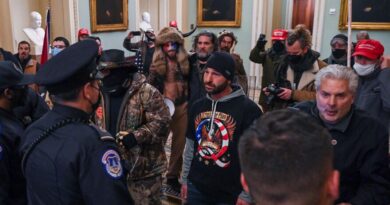‘QAnon Shaman’ stays in jail as judge slams his arguments: ‘So frivolous as to insult the Court’s intelligence’

He said on “60 Minutes+” last week that the Capitol riots were “not an attack on this country,” while his attorney has argued that he was actually a peaceful protester and wasn’t really armed when he was filmed storming the building with a spear.
On Monday, Lamberth denied Chansley’s motion for release in a scathing memorandum that rejected his arguments as “meritless,” “mistaken” and “so frivolous as to insult the Court’s intelligence.” The judge said that Chansley was too dangerous to release and continues to pose a threat to the public.
“The statements defendant has made to the public from jail show that defendant does not fully appreciate the severity of the allegations against him,” Lamberth wrote. “To the contrary, he believes that he — not the American people or members of Congress — was the victim on January 6th.”
Chansley is charged with violently entering the Capitol, among other felony charges, and prosecutors have urged the court to keep him in jail. Chansley’s attorney, Albert Watkins, did not immediately return a request for comment late Monday.
The 33-year-old Phoenix resident quickly became one of the most recognizable people charged in the Capitol riot, in part because of the eccentric costume he wore while sitting in Vice President Mike Pence’s chair. His connection to QAnon, an extremist ideology that spreads a sprawling set of false claims, has also highlighted the movement’s role in the Jan. 6 riot.
He made headlines soon after his arrest when he asked to be fed only organic foods, citing his obscure religious beliefs, and begged to be released after Watkins said he lost 20 pounds in jail. Watkins also made a public plea for a pardon from President Donald Trump, which was ignored. Chansley has filed multiple motions for release before his trial, but none have succeeded.
On Monday, Lamberth, a fiery presence in D.C. courts appointed by President Ronald Reagan in 1987, eviscerated the alleged rioter’s claims one by one.
Chansley has repeatedly argued that he acted peacefully on Jan. 6 when he helped lead a pro-Trump mob into Congress in an insurrection that left one police officer and four others dead.
But the judge pointed to videos, photos, social media posts and police interviews that he said clearly contradict those claims. “Defendant’s perception of his actions on January 6th as peaceful, benign and well-intentioned shows a detachment from reality,” Lamberth wrote.
Video shows Chansley leading the breach of the U.S. Capitol while holding a six-foot pole topped with a spear tip, authorities said. Prosecutors added that Chansley forced his way into the Senate chamber, where he sat in Pence’s chair and left a note declaring “ITS ONLY A MATTER OF TIME JUSTICE IS COMING!”
In social media posts before the riot, Chansley also advocated for “identifying and then hanging those he believes to be traitors within the United States government,” according to court documents. FBI agents say that in interviews with them Chansley said he had plans to go to the Arizona Capitol and that he might engage in similar acts in the future.
In his motion for release, Chansley claimed that the spear he carried was actually a “flagpole” with a “finial spear” on its tip. He argued that the object should not be considered a weapon, because similar flagpoles hang within the halls of multiple federal buildings across the country.
The judge did not buy that reasoning.
“By defendant’s logic, knives would not be considered dangerous weapons due to their availability in government building cafeterias,” Lamberth wrote. “The Court declines to adopt defendant’s ‘readily-available-in-government-buildings’ standard for determining whether an object is a ‘dangerous weapon’.”
The judge also said that Chansley “blatantly lied” when he claimed that a police officer waved him into the building, a claim that was contradicted by security footage and other videos filed by prosecutors. He said Chansley’s suggestion that he entered the building in a calm “third wave” of rioters, only after the Capitol had been violently breached by others, was false.
“To the contrary, he quite literally spearheaded [the breach],” Lamberth wrote.
Finally, Lamberth rejected Watkins’s argument that he could not meet confidentially with his client because of coronavirus restrictions in the jail where Chansley is detained.
“The issue is that when defense counsel is able to speak with his client, he squanders the opportunity for private conversations, preferring instead to conduct a public interview,” Lamberth wrote. “Such media appearances are undoubtedly conducive to defense counsel’s fame. But they are not at all conducive to an argument that the only way defense counsel could privately communicate with his client is if defendant were temporarily released.”
In fact, Chansley was able to privately contact Watkins over videoconference in a room with a closed door to participate in the “60 Minutes+” interview, the judge said.
“Given defense counsel’s decision to use what could have been a confidential videoconference on a media publicity stunt, that argument is so frivolous as to insult the Court’s intelligence,” Lamberth added.
After rebutting each of Chansley’s arguments, Lamberth denied his release on Monday.
The judge said Chansley showed a willingness to engage in violence and openly flout the law. There’s no reason to believe he wouldn’t do the same if he was released before the trial, which hasn’t yet been scheduled, Lamberth said.
“Defendant characterizes himself as a peaceful person who was welcomed into the Capitol building on January 6th by police officers,” the judge wrote. “The Court finds none of his many attempts to manipulate the evidence and minimize the seriousness of his actions persuasive.”
*** This article has been archived for your research. The original version from The Washington Post can be found here ***


